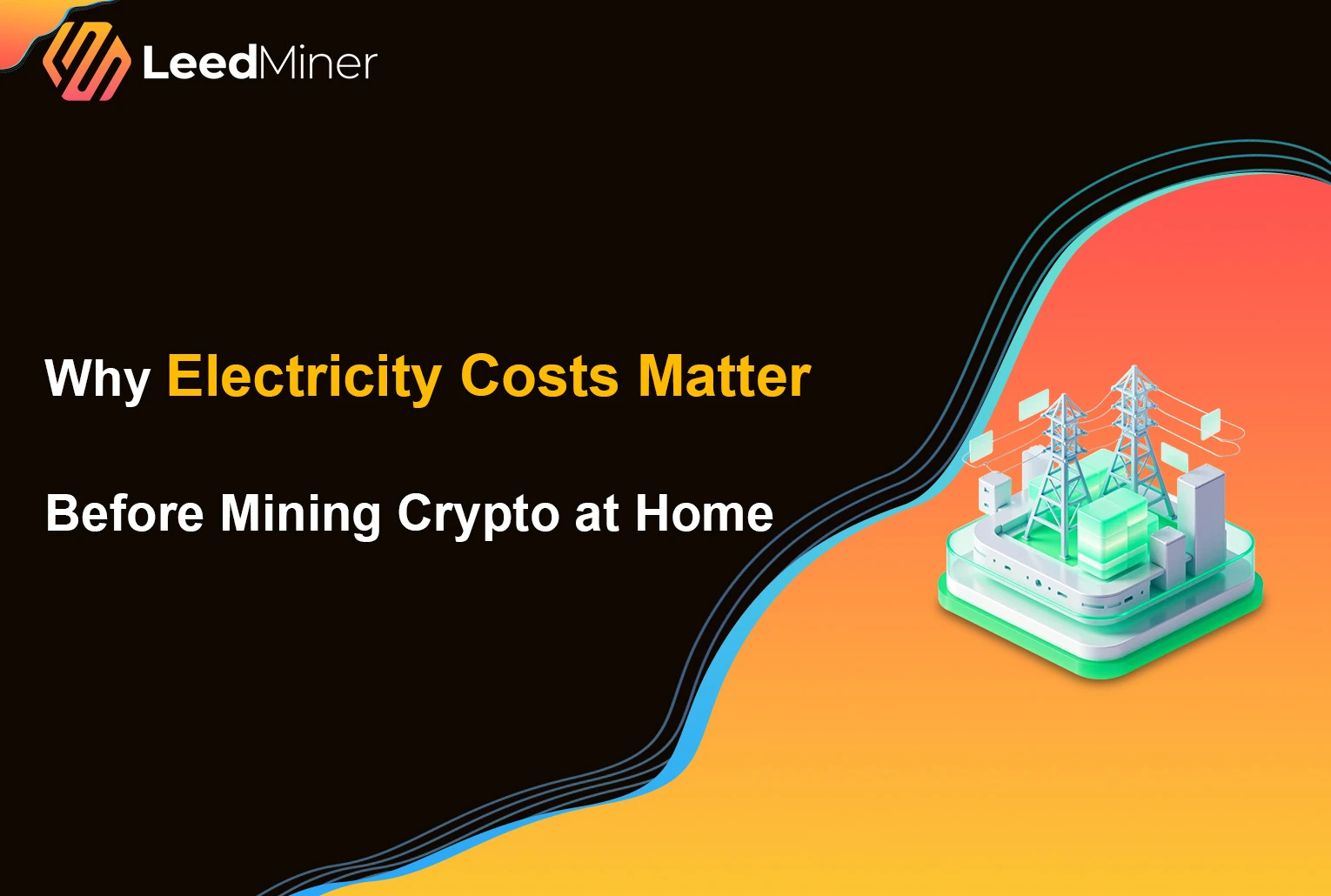SUMMARY
Home crypto mining can seem exciting—running your own rig, earning passive income, joining the blockchain revolution. But before you plug in your first ASIC or GPU miner, there are crucial realities you need to understand.
Whether you’re looking to mine Bitcoin, Litecoin, or other proof-of-work coins, here are ten key things you must know before mining crypto at home.
Electricity costs will make or break your profits
The biggest ongoing expense in mining is electricity. Mining rigs consume a lot of power 24/7. If your local electricity rate is above $0.10/kWh, it’s likely that your profits will shrink or vanish entirely.
To understand your profitability more clearly, use the Miner Profitability tool on the LeedMiner website. Input your electricity rate, and you’ll instantly see:
- Estimated daily revenue
- Electricity cost
- Payback period
- Electricity Ratio (how much of your income is consumed by power)
If your Electricity Ratio is below 30%, it’s generally a good sign. If it’s above 30%, you should reconsider—your margins may be too thin.
How do I know if home mining is profitable with my electricity cost? Use tools like LeedMiner’s Profitability Calculator to compare income vs electricity. A lower electricity ratio means higher potential profit.
Your home electrical capacity might not be enough
Most people focus on the miner’s hash rate—but ignore whether their home can physically support it. Here’s what to check before plugging in any ASIC.
Not all miners come with standard 110V plugs. Some use C13/C19, PDU-style, or bare-end cables. Bitmain miners may include power cords with C13 or C19 heads. Other brands (like Goldshell or IceRiver) may ship without cables. You may need to buy separate 10A–16A rated cables, depending on the power draw.
Always confirm cable compatibility with the seller before purchasing.
You must also know how much current your wall circuit can carry:
| Home Type | Max Amps per Circuit | Typical Voltage |
|---|---|---|
| Older Homes | 15A | 110–120V |
| Newer Homes | 20A | 120–240V |
To estimate your rig’s draw: Wattage ÷ Voltage = Amps For example, 3500W ÷ 240V = 14.6A — nearly maxing out a 15A circuit.
Overloading leads to breaker trips, overheating wires, or even performance throttling on some miners. Consider installing a dedicated 20A or 30A breaker and 240V socket if needed.
Noise levels are surprisingly high
While modern home-friendly ASICs like Goldshell Box series or iBelink BM-S3 are quieter than older rigs, noise is still present.
High-end ASICs like the Antminer S21 produce around 75–80dB, equivalent to a vacuum cleaner. Even small miners can create a low hum that’s annoying in bedrooms or shared spaces.
Solutions include placing rigs in basements, garages, or sound-insulated boxes, using noise-dampening foam or enclosures, or considering immersion cooling if you’re technically advanced. Noise builds up. A single unit is tolerable—three or more becomes oppressive.
Can I mine Bitcoin quietly at home? Most ASIC miners are not suitable for silent environments. Consider immersion cooling or noise-insulated enclosures.
Heat control can be a bonus or a major problem
Mining rigs are essentially space heaters with a side job. This can be good or bad depending on where you live.
In cold climates, rigs can help heat your home, saving you money during winter. Some miners duct hot air directly into rooms.
In warm climates, you’ll face overheating risks and may need ventilation fans, ducting to exhaust hot air, or dedicated air conditioning. Summer heat combined with multiple miners can lead to performance throttling or hardware damage.
Not all coins are profitable to mine
Most ASICs today are used to mine BTC (SHA-256) or DOGE (Scrypt, dual-mined with LTC). These coins have stood the test of time and survived bear markets. Their price performance and exchange liquidity make them reliable choices.
BTC home mining is difficult due to high network difficulty. Even if BTC hits $250K in 2025, the expected hash rate increase may outpace profitability for home users.
New PoW coins like ALEO or Ironfish offer shorter payback periods, but they are highly speculative. Their prices are volatile, and long-term sustainability is uncertain. Equipment resale value may drop quickly if the coin fails.
What’s better for home mining—ASIC or GPU? ASICs are more profitable but louder and power-hungry. GPUs are more flexible but less efficient.
Understand ASIC vs GPU mining in 2025
Modern ASICs can mine multiple coins under one algorithm. For example, Scrypt miners (like Antminer L7 or ElphaPex DG2+) mine LTC and auto-merge-mine up to eight other coins, most notably DOGE. This multi-coin revenue stream improves stability.
GPU mining is mostly obsolete after Ethereum’s transition to Proof of Stake. Only a few niche PoW coins remain, and ROI is poor unless electricity is nearly free.
A better use for GPUs now is AI compute leasing (e.g., Render Network, Vast.ai) or gaming and rendering workloads. GPU rigs still have value, but not for crypto mining in 2025.
A reliable internet connection is essential
Mining isn’t a high-bandwidth activity, but it is latency-sensitive. Your miner must stay connected to the pool server to receive and submit shares in real time.
What you need:
- Stable, wired Ethernet (preferred over Wi-Fi)
- At least 5–10 Mbps download and upload
- A UPS backup (battery power) to avoid sudden reboots during outages
Even 1–2 hours of downtime a day can affect monthly earnings. If you have unreliable internet or frequent outages, consider using a 4G/5G failover router or relocating the miner to a more stable environment.
Beware of double NAT or strict firewalls from ISPs—some configurations may block pool communication.
Be ready for technical troubleshooting
Mining isn’t plug-and-play. Even if you’re using user-friendly miners like the Goldshell Box or Bitmain L9, you will encounter issues.
Common issues include:
- Pool connectivity failures
- Firmware upgrades
- Overheating and throttling
- Hash rate fluctuations
- Dust accumulation
- IP address conflicts on your network
What you’ll need:
- Basic networking knowledge
- Access to the miner’s dashboard via LAN
- Research skills and community support (Reddit, Discord, Telegram)
- Small toolkit: thermometer, Ethernet cables, replacement fans
Mining pools vs solo mining
A mining pool is a group of miners working together to increase the chance of earning block rewards, which are then split based on hash rate contribution.
If you’re a home miner, you must use a pool. Solo mining is statistically near-impossible for BTC and LTC without a massive farm.
What to look for in a pool:
- Low fees (1–2%)
- Payout method (PPS, PPLNS, FPPS)
- Server location
- Minimum payout thresholds
- Reputation and uptime history
Is solo mining still possible at home? Technically yes, but for most users, it’s highly unprofitable unless you mine a brand-new coin early.
Regulatory and tax implications exist
Just because crypto is decentralized doesn’t mean it’s unregulated.
Some residential zoning laws may prohibit industrial-level power usage. Your utility provider may flag high electricity usage as commercial behavior and potentially cut service.
Mining profits are taxable in many regions. You may owe taxes on:
- The value of mined coins when received
- Capital gains if sold at a higher price
- Equipment depreciation (possibly deductible)
Consult a crypto-aware tax advisor. Keep logs of:
- Mining income
- Exchange rates
- Equipment receipts
- Electricity bills
Bonus tip: Before buying a miner, consider its exit value. Can you resell this machine if conditions change? Will it hold its value? Flagship models tend to retain resale value better than experimental machines.
Conclusion
Mining crypto at home can still be rewarding—but only if you treat it as a serious technical and financial undertaking. From wiring to wallets, every detail matters. Use tools like LeedMiner’s profitability calculator to evaluate real-world numbers before making any investment. Research the coins, understand the risks, and make sure your home is ready—electrically, structurally, and logistically.
Success in home mining today comes not from luck, but from preparation.



